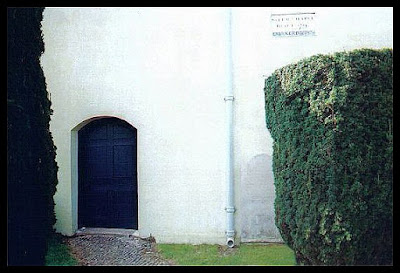I came across this rather lovely chapel in 2008, whilst in a friends car on the way to Exmouth. Knowing nothing about it at the time, we stopped to investigate and take some photos. However, it also has a lot of history attached to it, spanning from Devon in England to a tentative connection with Salem in Massachusetts, USA.
A square building with a hipped roof; the plastered walls of the chapel and assembly room are thick enough to be cob on stone rubble footings. A lovely old and mellow red brick wall at the front includes square gate posts, 19th century cast iron gates and a delightful wrought iron overthrow with lamp holder, adorned with scrolls and twiddly bits - a technical word, that! ;)
The construction of the roof is unique, providing a massive attic. This was ideal for storing smuggled items, with the advantage of a hidden lookout from where any approaching Revenue Men could be seen.
This reminds me of Rudyard Kipling's poem A Smugglers Song, in which a parson is included in this refrain...
"Five and twenty ponies,
Trotting through the dark -
Brandy for the Parson, 'Baccy for the Clerk.
Laces for a lady; letters for a spy,
Watch the wall my darling while the Gentlemen go by! "
It wasn't open but I was able to take these two photos through the window.
The tiny churchyard is enclosed by a whitewashed rubble and brick wall.
And the tenuous connection with Salem, Massachusetts? Salem was first settled by Europeans in 1626, led by Roger Connant. Although this was before Salem Chapel was built, the name Salem was a shortened version of Jerusalem and was popularly used as chapel and place names, and Roger Connant himself was born in East Budleigh.
The adjacent assembly room, below.
The front of the assembly room comprises two early 19th century sash windows containing thirty panes. These are either side of a later four panelled door. As seen below, the end of the assembly building contains a wide doorway which leads to a basement.



















Hi Eileen. Thank you for posting the photos of Salem Chapel. It is a particular favourite of mine. I have a potential project you may like to get involved in involving photographing the chapel. Would you be interested in discussing it?
ReplyDeleteHello Jan,
ReplyDeleteI don't know why but I wasn't notified of your comment and I only came across it by accident whilst checking something else out, so big apologies for not replying before now. Re your project, and if it isn't too late, perhaps you could email me the details on eileenwright@gmail.com
Cheers,
Eileen